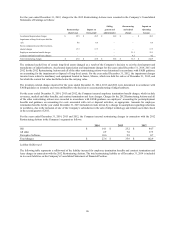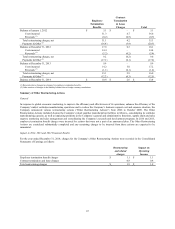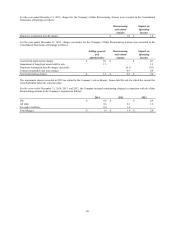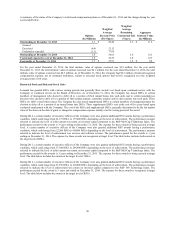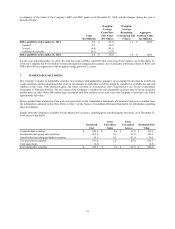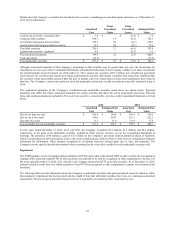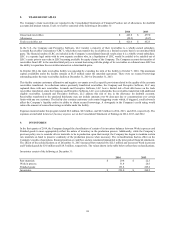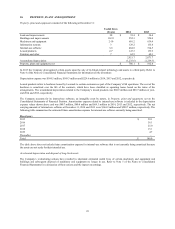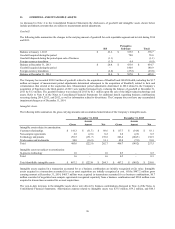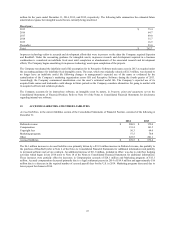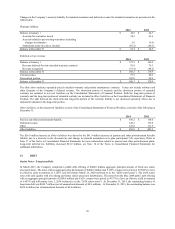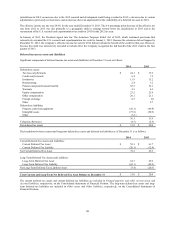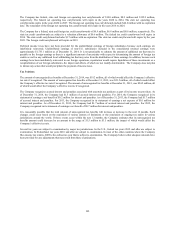Lexmark 2014 Annual Report Download - page 98
Download and view the complete annual report
Please find page 98 of the 2014 Lexmark annual report below. You can navigate through the pages in the report by either clicking on the pages listed below, or by using the keyword search tool below to find specific information within the annual report.
8. TRADE RECEIVABLES
The Company’s trade receivables are reported in the Consolidated Statements of Financial Position net of allowances for doubtful
accounts and product returns. Trade receivables consisted of the following at December 31:
2014 2013
Gross trade receivables $ 443.8 $ 477.0
Allowances (22.2) (24.7)
Trade receivables, net $ 421.6 $ 452.3
In the U.S., the Company and Perceptive Software, LLC transfer a majority of their receivables to a wholly-owned subsidiary,
Lexmark Receivables Corporation (“LRC”), which then may transfer the receivables on a limited recourse basis to an unrelated third
party. The financial results of LRC are included in the Company’s consolidated financial results since it is a wholly-owned subsidiary.
LRC is a separate legal entity with its own separate creditors who, in a liquidation of LRC, would be entitled to be satisfied out of
LRC’s assets prior to any value in LRC becoming available for equity claims of the Company. The Company accounts for transfers of
receivables from LRC to the unrelated third party as a secured borrowing with the pledge of its receivables as collateral since LRC has
the ability to repurchase the receivables interests at a determinable price.
In October 2014, the trade receivables facility was amended by extending the term of the facility to October 7, 2016. The maximum
capital availability under the facility remains at $125 million under the amended agreement. There were no secured borrowings
outstanding under the trade receivables facility at December 31, 2014 or December 31, 2013.
This facility contains customary affirmative and negative covenants as well as specific provisions related to the quality of the accounts
receivables transferred. As collections reduce previously transferred receivables, the Company and Perceptive Software, LLC may
replenish these with new receivables. Lexmark and Perceptive Software, LLC bear a limited risk of bad debt losses on the trade
receivables transferred, since the Company and Perceptive Software, LLC over-collateralize the receivables transferred with additional
eligible receivables. Lexmark and Perceptive Software, LLC address this risk of loss in the allowance for doubtful accounts.
Receivables transferred to the unrelated third-party may not include amounts over 90 days past due or concentrations over certain
limits with any one customer. The facility also contains customary cash control triggering events which, if triggered, could adversely
affect the Company’s liquidity and/or its ability to obtain secured borrowings. A downgrade in the Company’s credit rating would
reduce the amount of secured borrowings available under the facility.
Expenses incurred under this program totaled $0.6 million, $0.5 million, and $0.5 million in 2014, 2013, and 2012, respectively. The
expenses are included in Interest (income) expense, net on the Consolidated Statements of Earnings in 2014, 2013, and 2012.
9. INVENTORIES
In the first quarter of 2014, the Company changed the classification of certain of its inventory balances between Work in process and
Finished goods to more appropriately reflect the nature of inventory in the production process. Additionally, while the Company’s
previous policy was to consider all raw materials to be in production upon their receipt, the Company has begun to maintain certain
raw materials on hand to preserve continuity of the production process when necessary. The reclassifications had no effect on the
Company’s results of operations, financial position or cash flow and are considered immaterial to the prior period financial statements.
The effects of the reclassifications as of December 31, 2013 increased Raw materials by $22.3 million and decreased Work in process
and Finished goods by $3.8 million and $18.5 million, respectively. The values shown in the table below reflect these reclassifications.
Inventories consist of the following at December 31:
2014 2013
Raw materials $ 29.8 $ 22.3
Work in process 31.4 20.3
Finished goods 191.8 225.6
Inventories $ 253.0 $ 268.2
94




